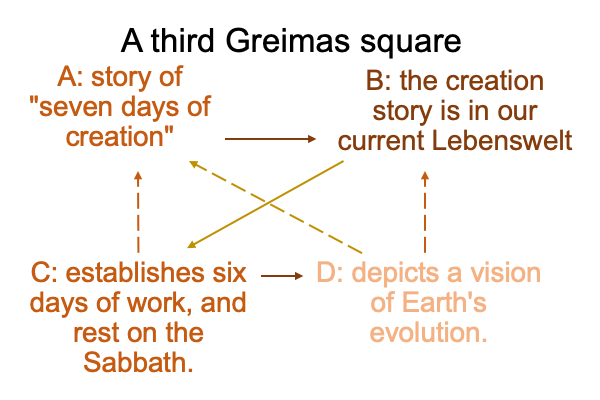0017 What is a Lebenswelt?
A Lebenswelt is German for a “living world”.
0018 In chapter three, Loke discusses the time spans of creation. The universe is around 14Byr (billions of years old). The Earth is 4.5Byr. If the solar system rotates around the galactic center every 250 million years, then the solar system has completed only 18 orbits of the galactic center. The solar system is 18 galactic years old.
Does that seem old?
0019 Could there be an eyewitness to the evolutionary construction of our home, the Earth?
Plus, why would an eyewitness portray the vision as a sequence of seven days?
The answer to the second question is straightforward. The Creation Story, the first chapter of Genesis, is used to establish the sabbath as the day of the Lord. Work six days and rest, along with God, on the seventh. If someone loses count, watch the phases of the moon. The heavens keep track of time. Time passes on Earth, as it does in heaven.
0020 The Creation Story takes us far upstream the river of time, to long before De Nile. Loke quotes Saint Augustine, asking what kind of days are these. They defy our sensibilities and challenge our imagination. The Young Earth Creations reply, saying, “These are literal days, with evening and morning.”
So, they could belong to a visionary.
0021 To me, the first chapter of Genesis belongs to our current Lebenswelt, yet looks past its beginning (which I call, “the first singularity”) into the Lebenswelt that we evolved in. It is a recital, in speech-alone talk, describing a sequence of… can I say?.. developments that could not be witnessed by a person, except as a series of visions.
Here is a Greimas square where the Creation Story is the focus of attention.

The final term, D, contrasts with C, speaks against A and complements B.
D contrasts with C because it is like a formal cause compared to C as a final cause.
D speaks against A in that the story does not proclaim itself to be a vision. How can it be a vision if the Genesis text does not say that it is a vision? Well, some Biblical scholars say that the Creation Story is something like a vision. It is the construction of the Temple of the Heavens and the Earth.
Finally, D complements B, because the first chapter of Genesis is one of the oldest written origin stories known to scholars. In fact, archaeologists conclude that the literary style of the Creation Story is very much in tune with other written religious proclamations of the ancient Near East. The first chapter of Genesis may be older than writing.
0022 And, that brings me back to the term, “Lebenswelt”.
The animal version of this word is “Umwelt”, technically defined as the world of significance for any particular animal. The dog’s Umwelt is full of aromas. The bat’s Umwelt is full of acoustic echoes. The eagle’s Umwelt includes tiny clues to the motion of animals through grass. The human’s Umwelt includes all of nature, plus ourselves. As soon as hominins start walking on two feet, their hands are free to gesture to one another. So begins the evolution of our Lebenswelt, our world of significance. Our Lebenswelt includes both nature and culture. The German word, “Lebenswelt”, transliterates into “living world”.
0023 According to Razie Mah’s masterwork, The Human Niche (available at smashwords and other e-book venues), the human niche consists of the potential of triadic relations. Signs are triadic relations. So are category-based nested forms. Consequently, our Lebenswelt is perfused with signs and category-based nested forms (which can be proto-semiotic). Sign-processing is one of the key hominin adaptations.
0024 So, a question arises, “Is the first chapter of Genesis a sign of the evolutionary record?”
Loke does not address this question.Nevertheless it bears on his discussion on the time spans of geological and biological evolution in contrast to the days of creation.
